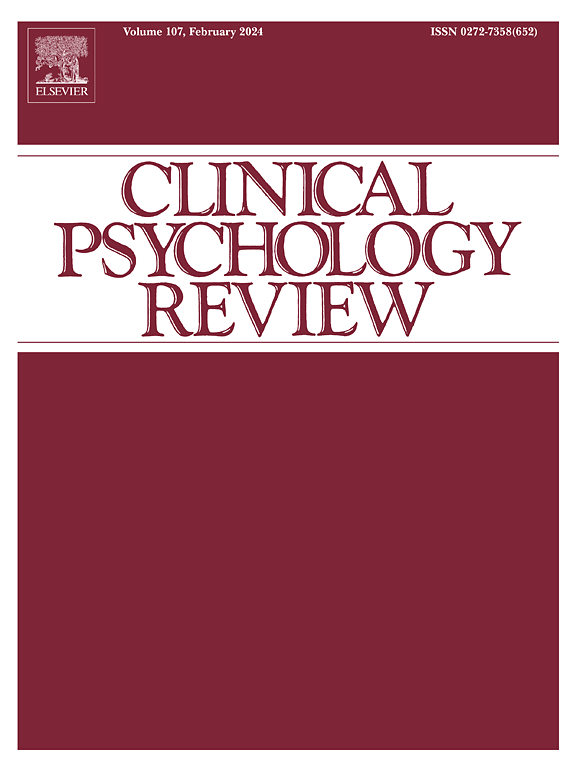Growing through adversity: A meta-analytic and conceptual elucidation of the relationship between posttraumatic stress and posttraumatic growth among youth
IF 12.2
1区 心理学
Q1 PSYCHOLOGY, CLINICAL
引用次数: 0
Abstract
Trauma may engender both posttraumatic stress symptoms (PTSS) and posttraumatic growth (PTG) among youth, but what is the nature of the relationship between these variables and what does it imply about youths' recovery trajectories? To explore this, PubMed, PsycINFO, Scopus, ERIC, and ProQuest Dissertations and Theses Global were searched, supplemented by reference trails, journal searches, and expert consultations, to identify quantitative studies on PTSS and PTG in youth (mean age ≤ 19 years). This resulted in 63 eligible articles. Both linear (n = 53) and curvilinear (n = 12) estimates were meta-analysed using random-effects models. Linear dependent estimates were pooled using weighted corrected averages and curvilinear dependent effects were clustered using robust variance estimation. The pooled linear estimate was r = 0.2028 [95 % CI 0.1348; 0.2689], p < .0001, based on 53 independent estimates and a total sample size of 33,774.6. The pooled curvilinear estimate was b = −0.199 (SE = 0.0573, p = .012). Moderator analyses further revealed a significant cultural influence, with Western youth (r = 0.3100 [95 % CI 0.1977; 0.4142], N = 6141) demonstrating a stronger association between PTSS and PTG compared to their Eastern counterparts (r = 0.0727 [95 % CI −0.0130; 0.1574], N = 21,778.42). The findings paint a nuanced and complex picture of posttrauma responses among youth, ultimately underscoring that, while PTSS and PTG can coexist, PTSS that are too excessive may not be conducive to PTG.
逆境成长:青少年创伤后应激与创伤后成长关系的元分析与概念阐释
创伤可能在青少年中产生创伤后应激症状(PTSS)和创伤后成长(PTG),但这些变量之间的关系的本质是什么?它对青少年的恢复轨迹意味着什么?为此,我们检索了PubMed、PsycINFO、Scopus、ERIC和ProQuest dissertation and Theses Global,并辅以参考文献、期刊检索和专家咨询,以确定青少年(平均年龄 ≤ 19 岁)中PTSS和PTG的定量研究。这产生了63个符合条件的条目。使用随机效应模型对线性(n = 53)和曲线(n = 12)估计值进行meta分析。线性相关估计使用加权校正平均值进行汇总,曲线相关效应使用稳健方差估计进行聚类。合并线性估计r = 0.2028[95 % CI 0.1348;0.2689], p & lt; 。0001,基于53个独立估计,总样本量为33,774.6。合并曲线估计值为b = −0.199 (SE = 0.0573,p = 0.012)。调节因子分析进一步揭示了显著的文化影响,西方青年(r = 0.3100[95 % CI 0.1977;0.4142], N = 6141),表明PTSS和PTG之间的相关性强于东部地区(r = 0.0727[95 % CI−0.0130;0.1574), N = 21778点)。研究结果描绘了年轻人创伤后反应的微妙而复杂的图景,最终强调,虽然创伤后应激障碍和创伤后应激障碍可以共存,但过度的创伤后应激障碍可能不利于创伤后应激障碍。
本文章由计算机程序翻译,如有差异,请以英文原文为准。
求助全文
约1分钟内获得全文
求助全文
来源期刊

Clinical Psychology Review
PSYCHOLOGY, CLINICAL-
CiteScore
23.10
自引率
1.60%
发文量
65
期刊介绍:
Clinical Psychology Review serves as a platform for substantial reviews addressing pertinent topics in clinical psychology. Encompassing a spectrum of issues, from psychopathology to behavior therapy, cognition to cognitive therapies, behavioral medicine to community mental health, assessment, and child development, the journal seeks cutting-edge papers that significantly contribute to advancing the science and/or practice of clinical psychology.
While maintaining a primary focus on topics directly related to clinical psychology, the journal occasionally features reviews on psychophysiology, learning therapy, experimental psychopathology, and social psychology, provided they demonstrate a clear connection to research or practice in clinical psychology. Integrative literature reviews and summaries of innovative ongoing clinical research programs find a place within its pages. However, reports on individual research studies and theoretical treatises or clinical guides lacking an empirical base are deemed inappropriate for publication.
 求助内容:
求助内容: 应助结果提醒方式:
应助结果提醒方式:


